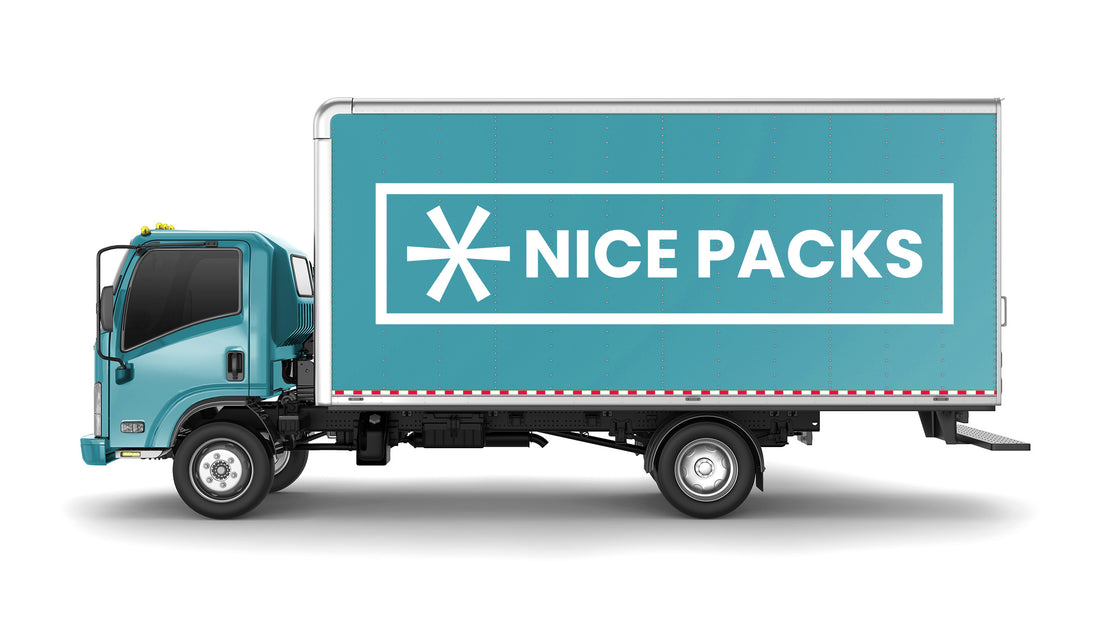When it comes to shipping temperature-sensitive items, the stakes are high. Whether it's food, medicine, or other perishable goods, maintaining the right temperature throughout the shipping process is crucial to ensuring the product arrives in good condition.
In this blog post, we will explore the concept of temperature-sensitive goods, highlight the importance of temperature control during shipping, discuss the risks of failing to maintain proper temperatures, and provide best practices to ensure that your shipment remains at the optimal temperature from the start to finish. Let's get started.
What Do You Mean By Temperature-Sensitive Shipping?

Credit: Envato Elements/ baspentrubas
Temperature-sensitive shipping, also known as cold chain shipping or temperature-controlled shipping, is a complex process used to transport goods that require specific temperature ranges to preserve their quality, safety, and efficacy. This process involves a combination of specialized packaging, containers, and transportation equipment that can maintain the required temperature range throughout the entire shipping process, from origin to destination.
Here is how the process of cold chain shipping takes place:
1) Pre-Conditioning
Before the shipment is loaded into the container or vehicle, the temperature-controlled packaging is pre-conditioned to the desired temperature range. This can involve cooling or heating the packaging material to the correct temperature.
2) Loading
The pre-conditioned shipment is loaded into the temperature-controlled container or vehicle. The container or vehicle is equipped with a temperature control system that can regulate the temperature inside the container.
3) Adjustments
If the temperature inside the container or vehicle goes outside the desired range, the temperature control system will make adjustments to bring the temperature back to the correct range.
4) Unloading
Once the shipment reaches its destination, it is unloaded from the temperature-controlled container or vehicle. The temperature of the shipment is checked again to ensure that it is within the desired range.
Understanding Temperature-Sensitive Items

Credit: Envato Elements/ furmanphoto
As mentioned before, temperature-sensitive items are products that have a specified temperature range that must be maintained to preserve their quality, safety, or efficacy. This temperature range can vary depending on the goods and can range from below freezing to above room temperature. Examples of temperature-sensitive goods include:
1) Pharmaceuticals
Many medications are sensitive to temperature, and exposure to extreme temperatures can cause them to lose their efficacy or even become dangerous. Insulin, vaccines, and some chemotherapy drugs are examples of pharmaceuticals that require temperature control during storage and transportation.
2) Biologics
Biologic products, such as monoclonal antibodies, organs, blood products, and tissue grafts, are also highly sensitive to temperature changes. Biologics are complex, large-molecule products that can lose their potency or become unstable if exposed to extreme temperatures.
3) Food and Beverage
Perishable items such as fresh produce, meat, and dairy products require temperature control during shipping to prevent spoilage. The specific temperature range depends on the type of food or beverage, but generally, perishable items need to be kept at a temperature between 32°F and 40°F (0°C and 4.4°C).
4) Chemicals or Dangerous Goods
Some chemicals or dangerous goods such as explosives, radioactive materials, or hazardous materials require specific storage and transport conditions. Exposure to high temperatures can result in degradation or hazardous reactions.
The Risks of Poor Temperature Control

Credit: Envato Elements/ larisikstefania
Poor temperature control during shipping can result in various risks, including:
1) Reduced Product Efficacy
Exposure to temperatures outside of the recommended range can cause temperature-sensitive products to lose their efficacy. For example, vaccines can lose their potency if they are exposed to temperatures outside of the recommended range, rendering them ineffective.
2) Spoilage
Perishable items such as food and beverages can spoil if they are exposed to temperatures outside of the recommended range. This can result in changes in texture, flavor, and color, and can even pose a risk to customer safety if bacterial growth or contamination occurs.
3) Safety Risks
Exposure to extreme temperatures can pose safety risks for some temperature-sensitive shipments. For example, chemicals can become volatile and dangerous if exposed to heat or light during transportation or storage, posing a risk to the safety of transportation personnel and the general public. Additionally, failure to maintain the proper temperature range can also result in the release of toxic fumes or explosions, leading to severe accidents.
4) Financial loss
The cost of temperature-sensitive items can be high, and any loss due to poor temperature control can result in financial loss for the manufacturer, distributor, or retailer. These losses can include the direct cost of spoiled or ineffective products, the cost of discarding or replacing these products, and potential legal liabilities resulting from customer harm or non-compliance with regulatory standards. Poor temperature control can also damage the reputation of the company and result in lost business and reduced profitability.
Best Practices for Shipping Temperature-Sensitive Products

Credit: Envato Elements/ seventyfourimages
Since temperature-sensitive products are so sensitive, extra care needs to be taken during the shipping process to ensure that the shipments arrive in perfect condition. Here are some best practices to consider:
1) Pre-Shipment Preparation
Before shipping temperature-sensitive products, ensure that the product is properly packaged and labeled. The packaging should be suitable for the specific temperature range required, and the label should indicate that the item is temperature-sensitive and requires specific temperature control during transportation. This ensures that everyone involved in the shipping process is aware of the product's sensitivity to temperature.
In addition to appropriate packaging and labeling, it may also be necessary to use coolants such as gel packs, dry ice packs, or other refrigerants to prevent any temperature loss.
2) Choose the Right Shipping Method
Selecting the appropriate shipping method is critical to maintaining temperature control. The choice of shipping method will depend on the specific temperature requirements, the distance to be covered, and the time in transit. For shorter distances and shorter transit times, refrigerated trucks or vans may be sufficient. However, for longer distances, air freight or expedited ground freight systems such as trains may be necessary to ensure timely delivery.
3) Monitor the Temperature
Temperature monitoring is essential to ensure that the product remains within the desired temperature range throughout the shipping process. To ensure accurate temperature monitoring, it's important to use high-quality temperature monitoring devices that are calibrated regularly.
These devices should be placed in strategic locations within the shipment box or container to provide a representative measurement of the temperature. If a temperature excursion is detected, appropriate corrective actions should be taken immediately to bring the product back within the desired temperature range.
4) Partner with a Reliable Logistics Provider
It's important to choose a reliable logistics provider or carrier with the necessary equipment, expertise, and experience to manage temperature-controlled shipments effectively. Whoever you choose, make sure that they are equipped with the latest temperature-controlled shipping technologies, including specialized packaging and temperature-controlled boxes. The carrier should also have a comprehensive quality management system in place to ensure that all shipping processes are in compliance with industry standards and regulations.
5) Develop a Contingency Plan
Despite taking all necessary precautions, unforeseen circumstances can still occur during shipping. Therefore, a contingency plan should be developed to address any unexpected temperature delays.
The plan should include clear procedures and responsibilities for all parties involved in the shipping process, including the logistics provider, manufacturer, distributor, and retailer. Additionally, it should also include steps for immediate corrective action to minimize the impact of any unexpected temperature excursions. Having a contingency plan in place can help minimize financial losses and reduce the risk of harm to consumers.
Technologies for Shipping Temperature-Controlled Products

Credit: Envato Elements/ YuriArcursPeopleimages
Advancements in technology have made it easier to maintain temperature control during shipping. Here are some helpful technologies that you can use:
1) Insulated Packaging Materials
Insulated packaging is a commonly used technology in temperature-controlled shipping, especially for short-term shipping of smaller quantities of temperature-sensitive items. It works by providing a barrier of thermal protection around the item being shipped, preventing external temperature fluctuations from affecting the internal temperature of the package.
Below are some commonly used insulated packaging materials used:
- Foam: Foam is a common material used in insulated packaging due to its high insulating properties and ability to absorb shock.
- Polystyrene: Polystyrene, also known as Styrofoam, is another commonly used material for insulated packaging. It is lightweight, affordable, and can provide a high level of thermal protection.
- Reflective Film: Lastly, reflective film is also used in insulated packaging to reflect heat and help to keep the contents cool, especially when exposed to direct sunlight or other heat sources. It is often incorporated into the packaging materials used to create temperature-controlled containers, boxes, and shipping envelopes.
Insulated packaging can be customized to fit the specific needs of the item being shipped. For example, it can be designed with different layers and thicknesses of insulation to provide more or less thermal protection. It can also be designed with different shapes and sizes to fit the item being shipped more efficiently and reduce the risk of damage during transit.
One disadvantage of insulated packaging is that it is typically only effective for short-term shipping. For longer durations or for items that require a more precise temperature range, other technologies such as refrigerated trucks may be necessary. Additionally, insulated packaging may not be suitable for items that are extremely temperature-sensitive, as even minor temperature fluctuations may be detrimental to the item's quality and efficacy.
2) Dry Ice Packs
Dry ice packs are a type of ice pack used to keep temperature-sensitive products, such as food, beverages, and pharmaceuticals, cold during transportation. They are made of a thin sheet or pouch that is filled with unique substances and materials that get activated when soaked in water. Once frozen, the pack can be placed in a shipping container with the temperature-sensitive product to maintain a cold temperature during transport.
What makes dry ice packs an excellent solution for temperature-sensitive shipments is their ability to maintain an ultra-low temperature for an extended period, typically between 48-72 hours. Unlike other coolants that require electricity or power to maintain the desired temperature range, these packs do not require any power source, which makes them a practical choice for shipping products to remote locations or during power outages. Furthermore, dry ice packs can be reused multiple times, which makes them a cost-effective option compared to other types of cold packs and gel packs.
3) Active Temperature-Controlled Packaging
Active temperature-controlled packaging is a technology used in temperature-controlled shipping that uses a power source and a temperature control system to maintain the required temperature range during shipping. This type of packaging is often used for high-value items or products that require strict temperature control, such as pharmaceuticals, vaccines, and biologics. It typically consists of a thermal container, a power source (e.g., battery), and a temperature control system (e.g., compressor or thermoelectric cooler). The power source provides the energy needed to maintain the temperature inside the container, while the temperature control system monitors the temperature and adjusts it as needed to maintain the desired range.
Although active temperature-controlled packaging is reliable, it is generally more expensive than other temperature-control solutions and requires specialized expertise to operate and maintain.
4) Refrigerated Containers
Refrigerated containers, also known as "reefers," are large shipping containers or cargo boxes that are designed to maintain a specific temperature range during shipping. These containers are often used for shipping large quantities of temperature-sensitive items, such as perishable food products or pharmaceuticals. They consist of compressor-based cooling systems, which circulate chilled air throughout the container to maintain the desired temperature range. The container is also equipped with sensors and controls to monitor the temperature and adjust the cooling system as needed to maintain the required temperature range.
One advantage of refrigerated containers is their ability to maintain a very precise temperature range over a longer duration of time. They are also able to maintain a wider range of temperatures than some other technologies, such as insulated packaging or phase change materials. This makes them ideal for shipping large quantities of perishable items, such as fresh produce or meat products. However, refrigerated containers are typically more expensive to use and require specialized equipment and infrastructure to load and unload. Additionally, they are not suitable for all shipping situations, as they require a constant power source to maintain the temperature control system.
Summary
Shipping temperature-controlled items is a critical process that requires meticulous planning and strict adherence to established procedures. Any deviation from the recommended temperature range during shipping can result in significant financial losses for the shipper. Therefore, it is crucial to follow best practices and use the latest technologies.
Stressed out about shipping your temperature-sensitive shipment? With Nice Packs, you can rest easy knowing that your products are in good hands. Our dry ice packs and shipping boxes are the perfect solutions for keeping your items at the recommended temperature range during shipping. Shop with us today.


